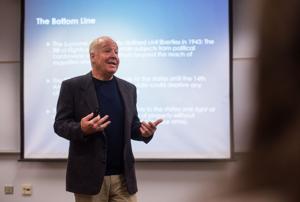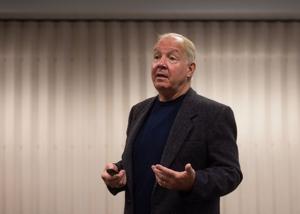(91outcomes.com - December 16, 2015) - A budget deal late Tuesday cleared the final omnibus spending bill with good news for ill Gulf War veterans. The treatment-focused, Gulf War Illness Research Program (GWIRP) will be renewed for another year, and with full funding.
The peer-reviewed medical research program is part of the Congressionally Directed Medical Research Program (CDMRP), a program funded within the U.S. Department of Defense (DoD) but takes its direction from Congress.
It's aim is simple and to the point: "To improve the health and lives of veterans who have Gulf War Illness."
Led by Rep. Phil Roe, M.D. (R-Tenn.) and Rep. Tim Walz (D-Minn.) in the U.S. House of Representatives and Senator Tammy Baldwin (D-Wis.) in the U.S. Senate, eighty Members and Senators called on the leadership of the Defense Appropriations Subcommittees to continue to adequately fund the program.
Among the 80 cosigners to the letters were Rep. Jeff Miller (R-Fla.) and Rep. Corrine Brown (D-Fla.), Chairman and Ranking Member, respectively, of the House Veterans Affairs Committee, Veterans' Affairs Subcommittee Chairs and Ranking Members Rep. Dan Benishek (R-Mich.), Rep. Mike Coffman (R-Colo., a Gulf War veteran himself), Rep. Julia Brownley (D-Calif.), Rep. Ann Kuster (D-N.H.) and Rep. Mark Takano (D-Calif.) , and Sen. Bernie Sanders (I-Ver.), past Chairman of the Senate Veterans' Affairs Committee.
Rep. Roe, member of the House Veterans' Affairs Committee, released the following statement at the time the funding request was made:
“As a member of the House Veterans Affairs Committee and a veteran myself, I believe we have a huge responsibility to ensure that these efforts continue, for these veterans and for current and future U.S. forces at risk of similar exposures and outcomes. ... This letter encourages appropriators to continue supporting this important research and I am proud to lead this effort.”
Sen. Baldwin, member of the Senate Appropriations Committee, said the following in the cosigned letter she led:
"While we have made progress in the fight against Gulf War Illness, many challenges remain. .... It is critical to the program’s success and accountability that it remains a stand-alone program within CDMRP."Rep. Walz, member of the House Veterans' Affairs Committee and the highest ranking enlisted soldier ever to serve in Congress, released the following statement on the letter request:
“When our warriors return from battle, it’s our duty as a grateful nation to provide them with the best care possible, based in sound medical research. In order to achieve this goal, we must continue to invest in research that helps us better understand the risks and exposures they faced in combat. That is why I am proud to join my friend and colleague, Rep. Roe, to lead this letter in support of the successful Gulf War Illness Research Program.”
According to the program's website:
"The Gulf War Illness Research Program (GWIRP) was initiated in 2006 to provide support for research of exceptional scientific merit to study the health effects of deployment on U.S. Warfighters during the 1990-1991 Persian Gulf War. The GWIRP challenges the scientific community to design high-impact research that will improve the health and lives of Veterans who have Gulf War illness (GWI).
"GWI is characterized by multiple, diverse symptoms that typically include chronic headache, widespread pain, cognitive difficulties, debilitating fatigue, gastrointestinal problems, respiratory symptoms, sleep problems, and other abnormalities that could not be explained by established medical diagnoses or standard laboratory tests. The population of Veterans affected by GWI is a subset of the nearly 700,000 U.S. Warfighters who served during the 1990-1991 Gulf War. Studies indicate that approximately 25-32% of Gulf War Veterans continue to experience symptoms associated with their deployment.
"The GWIRP focuses on funding innovative, competitively peer-reviewed research to (1) provide a better understanding of the pathobiology underlying GWI, (2) identify objective markers (biomarkers) for improved diagnosis, and (3) to develop treatments for the complex of GWI symptoms and their underlying causes. Our Vision is to make a significant impact on GWI and improve the health and lives of affected Veterans and their families."The program relies on consumer reviewers -- patients actually suffering from the condition being researched -- to help guide and steer it. According to one of the program's consumer reviewers, Vera Roddy, a U.S. Air Force Gulf War veteran from Milwaukee, Wis.:
"I have a deep respect for the entire CDMRP team and the fact that Consumer Reviewers are treated as equal partners. My experience has given me a renewed respect for the scientific process. With the understanding that quality research and development is a slow painstaking process; and that 25 years is a long time for veterans to wait for answers, I am excited that Gulf War Illness research is moving towards more human subjects studies with practical applications. I am less concerned with the cause of Gulf War Illness and more concerned with practical applications of how we can make life more functional for veterans with Gulf War Illness and their families."
Led by Veterans for Common Sense (VCS), the funding request was also supported by the American Legion, AMVETS, Disabled American Veterans (DAV), National Vietnam and Gulf War Veterans Coalition, Paralyzed Veterans of America (PVA) Sergeant Sullivan Center, Veterans of Foreign Wars (VFW), Vietnam Veterans of America (VVA). The program's renewal comes at the same funding level as the last three years, $20 million, precisely what Gulf War veteran advocates were seeking.
The signed Senate letter with all cosigners is available here: https://www.scribd.com/doc/260152211/Senate-Baldwin-Letter-to-Sac-d-Fy16-Gwirp-Final-2
The signed House letter with all cosigners is available here: https://www.scribd.com/doc/260152215/House-Roe-walz-Letter-to-HAC-D-GWIRP-Final-Fy16
-91outcomes.com



